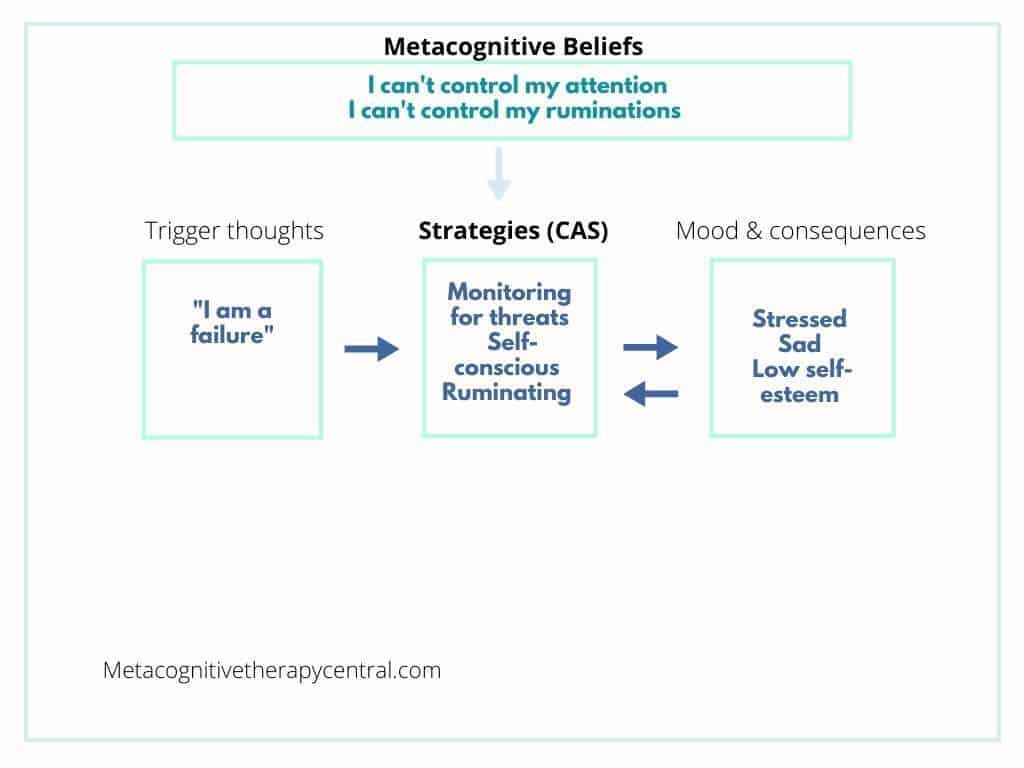
Did you know that the way you deal with your thoughts and feelings can intensify and maintain your negative emotions?
For example, when you worry, you probably feel nervous and stressed for a longer time. And the reason that you engage in worry, rumination, and other problem-solving strategies in the first place is because of your metacognitive beliefs.
Metacognitive beliefs shape what we pay attention to and what strategies we use to regulate thoughts and feelings. Metacognitive beliefs can cause psychological disorders because they encourage excessive worry and rumination, prolonging negative emotions.
So what are metacognitive beliefs, where do they come from, and can they be changed?

What are metacognitive beliefs?
Metacognitive beliefs are beliefs about the way we think and what pay attention to. They determine whether we pay attention to thoughts, feelings, and sensations or dismiss them so that we can pay attention to the world outside of us.
Metacognition means thinking about thinking, and metacognitive beliefs are generalized beliefs about thoughts and feelings and carry positive and negative information about how we should deal with thoughts and feelings.
According to Wells, the founder of Metacognitive therapy, metacognitive beliefs are the conductor in a large orchestra. In a large orchestra, there needs to be a conductor that produces a good overture. Likewise, metacognitive beliefs are the conductor of thinking. They decide whether we dismiss negative thoughts or ruminate and worry about them.
For example, most people with mental illness have these metacognitive beliefs: “Worry is uncontrollable” or “I need to worry so I can feel better.”
The first metacognitive belief is a negative Metacognitive belief that plays an important role in causing and maintaining disorders like anxiety and depression. The next one is a positive metacognitive belief that promotes worrying as helpful.
Metacognitive beliefs decide our strategies to handle thoughts and feelings. These strategies are rumination, worry, thought suppression, or monitoring of thoughts. These strategies are also called Cognitive attentional syndrome, (CAS). CAS prolongs negative thoughts and feelings and thereby maintains depression and anxiety.
- Metacognitive beliefs control the CAS and play an essential role in whether we get mentally ill or cope with difficulties in life in healthy ways.
- It is normal to have both positive and negative metacognitive beliefs.
Positive metacognitive beliefs
Positive metacognitive beliefs involve the usefulness of worry, rumination, threat monitoring, and other similar strategies. These metacognitive beliefs tell us that dealing with thoughts and feelings through rumination and worry is a good idea.
Examples of positive metacognitive beliefs are:
Worrying/ruminating helps me cope
Worrying helps me get things done
Rumination helps me understand
Something bad would happen if I didn’t worry
Analyzing my problems will help me find answers
On the surface, positive metacognitive beliefs seem reasonable. However, rumination and worry rarely help achieve what they promise and prolong negative feelings. Worry and rumination give an unbalanced view of things.
Ruminating and worrying about negative thoughts maintain distress
Negative metacognitive beliefs
Negative metacognitive beliefs are negative interpretations of thoughts, feelings, and symptoms. There are two categories of negative metacognitive beliefs: uncontrollability and danger beliefs.
Examples of uncontrollability metacognitive beliefs are:
I cannot control my thinking
If I don’t control my worry, it will control me
I can’t control my attention
Examples of danger/importance metacognitive beliefs are:
Worrying too much can harm me
Some thoughts could make me lose my mind
Strong emotions are dangerous
Bad thoughts have the power to make me do bad things
Some thoughts can make bad things happen
Thinking something makes it true
These negative metacognitive beliefs lead to the persistence of unhelpful coping strategies. For example, they lead to more worrying and rumination as an attempt to control these feared outcomes.
Negative metacognitive beliefs lead to more CAS (unhelpful coping strategies) because they magnify the sense of “threats”
| Positive metacognitive beliefs | Negative metacognitive beliefs Uncontrollability | Negative metacognitive beliefs Danger |
| Examples: Worrying/ruminating helps me cope Worrying helps me get things done Rumination helps me understand If I analyze why I feel this way, I’ll find answers Something bad would happen if I didn’t worry Focusing on possible threats can keep me safe It is important to control my thoughts Analyzing my problems will help me find answers | Examples: I cannot control my thinking If I don’t control my worry, it will control me I can’t control my attention | Examples: Worrying too much can harm me Some thoughts could make me lose my mind Strong emotions are dangerous Bad thoughts have the power to make me do bad things Some thoughts can make bad things happen Thinking something makes it true |
| This leads to the following CAS strategies: Worry Rumination Threat-monitoring (Overthinking) (Analysis) | This leads to the following CAS strategies: Continuing worry Continuing rumination Thought suppression Distraction Binge eating Alcohol abuse Self-harm Meditation | This leads to the following CAS strategies: Continuing worry Continuing rumination Threat-monitoring Thought suppression Reassurance seeking Distractions Numbing thoughts and feelings through alcohol, food, self-harm Rituals (mental and physical) Meditation |
Consequences: If the person finds a solution in a short amount of time or doesn’t have negative metacognitive beliefs, he/she can turn off worry/rumination and move on with life If the person has negative metacognitive beliefs, these will be activated soon Prolonged negative thoughts and feelings Feeling tired, demotivated, tense | Consequences: Because the person doesn’t believe that rumination/worry can be stopped, he/she will continue ruminating and worrying. He/she might use other coping strategies and distractions to stop ruminating/worrying. At some point, rumination happens on auto-pilot mode, and the person loses awareness of when it’s happening. Mental disorders like for example anxiety and depression. | Consequences: Because the person believes that thoughts and feelings are dangerous, they will use many different coping strategies to try to stop them from coming. For example, reassurance-seeking is common in people with anxiety and OCD. People with OCD believe in the importance of specific thoughts and therefore engage in rituals to “neutralize” dangerous thoughts. However, engaging in prolonged rituals maintains OCD and these people never get a chance to disconfirm that thoughts don’t have importance. Misinterpretation of bodily symptoms leading to more anxiety |

Metacognitive beliefs influence negative emotions
Thoughts and feelings only last a few seconds when they come up in the mind. If left alone, they are usually replaced by new thoughts and feelings.
However, rumination, worry, and other ways of handling thoughts prolong this process. Instead of only lasting three seconds, thoughts and feelings last longer and get more intense.
This process has something to do with the mind’s ability to heal itself.
The mind can heal itself, like the body can heal a broken arm. Thoughts, images, and impulses visit shortly but will disappear again. But, if we grab onto unwanted thoughts and feelings, we hinder the mind from regulating itself. This process is called the self-regulatory executive function model (S-REF) and was developed by Wells and Matthews (3).
When thoughts and feelings persist for a longer time, it is because of our metacognitive beliefs telling us to engage with thoughts that come up. Either to problem-solve or because we no longer think that we can control the process (But, if we leave these thoughts and images alone, they will pass through like grains of sand in a strainer).
Metacognitive beliefs control whether we deal with negative thoughts, and they are therefore the reason that negative feelings persist because they block self-regulation

Metacognitive beliefs cause depression
Rumination causes and maintains depression and is driven by positive metacognitive beliefs that lead people to think that it helps to understand their depression and solve it. Rumination is also driven by negative metacognitive beliefs that lead depressed people to think they can’t control it.
Since rumination causes depression, the metacognitive beliefs responsible for activating rumination are:
Ruminating helps me solve problems
Rumination helps me understand my depression
“If I analyze why I feel this way, I’ll find answers”
can’t control my depressive thoughts (rumination)
Depression is an illness in my brain beyond my control
Usually, negative thoughts set off ruminations because of positive metacognitive beliefs. People ruminate because they think that rumination will help them solve their problems.
However, extensive rumination prolongs sad feelings, which encourages more rumination. The bottom line is that metacognitive beliefs encourage rumination, and rumination causes depression.
Rumination is the process of perseveratively thinking about one’s emotions or problems without actively problem-solving or changing the circumstances for the better.

Metacognitive beliefs affect self-esteem
Self-critical rumination has been shown to maintain low self-esteem (4). According to metacognitive theory, self-critical rumination is activated by positive metacognitive beliefs and maintained by negative metacognitive beliefs, which perpetuate low self-esteem.
Self-critical rumination is an intense and persistent form of internal dialogue that expresses hostility toward the self when one is unable to attain one’s own high standards.
When negative emotions come up, self-critical thoughts can lead people to self-critical rumination if they have positive metacognitive beliefs. Automatically, attention is drawn toward past failures or mistakes.
If, at the same time, they also have negative metacognitive beliefs (meaning that they believe they are unable to shift attention away from these thoughts) they can get caught up in negative self-evaluation and dwelling on past mistakes. Over time, this will negatively impact general self-esteem because it increases and maintains self-critical thoughts.
Both self-critical rumination and metacognitive beliefs play a significant role in predicting low self-esteem, especially metacognitive beliefs about the danger and uncontrollability of that process. A better strategy for learning from past mistakes is through problem-solving instead of self-critical rumination.

Metacognitive beliefs predict work-related stress
In work-related stress, people typically worry about stressful events at work, negative relationships with colleagues and superiors, and their own performance. Worrying lead to more stress-related symptoms that compromise performance and concentration in a downward negative cycle. Worrying is activated by metacognitive beliefs:
My worry is uncontrollable
My worry can physically harm my body
Worry helps me cope
Stressed people not only worry but also use unhelpful coping strategies to deal with these stressful events at work: working more, unhealthy eating habits, consuming more alcohol, smoking cigarettes etc. These strategies, however, lead to more negative thoughts and feelings of stress.
Continuous use of the CAS (coping strategies) eventually affects cognitive abilities like reduced performance, poor memory, and concentration, which activates negative metacognitive beliefs about the dangers of stress.
In a study conducted at Harward University, scientists discovered that having danger-related metacognitive beliefs about stress (Stress is harmful to my mind/body) perpetuates stress, reduces performance, and contracts the blood vessels in the body. It is not healthy to be in this state all the time. This bodily response is typically associated with the negative effects of chronic stress (5).
According to health psychologist Kelly McGonigal at Stanford University, stress-related symptoms are not harmful by themselves. In fact, feelings of stress are a natural way for the body to prepare for challenging situations.
This TED talk discusses the study in more detail:
Which metacognitive beliefs predict mental illness the most?
Although both positive and negative metacognitive beliefs contribute to mental illness, negative metacognitive beliefs have the most impact on developing a mental illness, especially uncontrollability beliefs “I can’t control worrying/ruminating.”
Positive metacognitive beliefs make people activate coping strategies like worry and rumination, which after some time, cause a rise in symptoms like anxiety, sadness, and distress. And once these symptoms occur, negative metacognitive beliefs about not being able to control worry and the danger of worry are activated:
I can’t control my worry
Worrying makes me lose my mind
Worrying is harming my body
So when people no longer believe that they are able to stop worrying and ruminating, they won’t try to stop in the first place. This creates a cyclical effect that leads to more rumination and even other coping strategies like reassurance seeking and alcohol abuse to stop feeling distressed.
For example, people who suffer from Generalized anxiety disorder started to worry about things to prepare and cope with problems. But worrying for extended periods creates anxious symptoms (nervousness, uneasiness, faster heartbeat, restlessness), which activates negative metacognitive beliefs; I can’t control my worry and Worrying is harming my body.
At this point, the negative metacognitive beliefs signal that it is not possible to stop worrying and that worrying is harmful. It makes it hard to try to contain worry, so they continue to worry, and that way, maintain a generalized anxiety disorder.
Many people have positive metacognitive beliefs about worrying without developing mental illnesses. Most people can stop worrying once they have thought of solutions to their problems. This is because they don’t have uncontrollability metacognitive beliefs.
Bottom line
- Not all metacognitive beliefs have an equally negative effect on emotions.
- Negative metacognitive beliefs that maintain mental illness.
- Negative metacognitive beliefs about not being able to control thinking have the most direct effect on the maintenance of psychological disorders.

Where do Metacognitive Beliefs Come From?
General metacognitive beliefs are developed in childhood and adolescence, with some implicit metacognitions developing in babies at least as early as two months old. Typically, they are passed on to us from our families, friends, school, and life experiences.
Life experiences also seem to play a role in developing and strengthening metacognitive beliefs about overthinking. For example, people who have traumatic experiences start ruminating more because they want to make sure they don’t end up in a similar situation in the future (a positive metacognitive belief that thinking is helpful) (6).

Can metacognitive beliefs change?
Metacognitive beliefs can change, or at least, patients can weaken their metacognitive beliefs about rumination and worry through metacognitive therapy. Usually, it takes up to 10 sessions with a certified metacognitive therapist to reach a point where metacognitive beliefs are sufficiently weakened.
Weakened metacognitive beliefs mean that the patient, for example, no longer believes that worrying and ruminations are useful and that she feels in control of rumination and worry. Weakened metacognitive beliefs also mean that the patient no longer feels the need to worry and ruminate in response to negative thoughts, which in the end, allows the mind to self-regulate anxiety, depression, and stress.
What does science say about metacognitive beliefs?
More research supports the metacognitive model of psychological disorders that claims that repetitive thinking (CAS) controlled by metacognitive beliefs causes anxiety, depression, OCD, psychosis, and PTSD.
Metacognitive beliefs have been shown (7) to relate to a range of psychological disorders and symptoms (e.g., obsessive-compulsive symptoms, trauma symptoms, worry, and anxiety and depression symptoms.
Researchers have investigated the effects of experimentally induced metacognitive beliefs in people. In one study, the participants were told that they were connected to an EEG machine that could detect the thought “apple” and deliver an electric shock to another participant they had just met.
The participants were told that they could interrupt the electric shock by pressing a button within two seconds after the thought apple had come up in their minds.
In a comparison condition, participants were told that the EEG would detect the thought apple, but no information about shocks was given.
The results were interesting: the participants who were told about the shock experienced more intrusive thoughts (apple thoughts), more discomfort, more anger toward themselves, and greater efforts to avoid thinking. A metacognitive belief about the importance and danger of thoughts had been implanted in their minds.
The above shows the impact of metacognitive beliefs on mental well-being: believing that thoughts are important, and in this case, dangerous because they induce electric shocks, makes people use thought-controlling strategies that intensify distress. This is proof that metacognitive beliefs lead to the use of unhelpful coping strategies (CAS) and potentially cause mental illness (2)
Recent scientific work questions the conventional understanding of mental illness (that mental disorders are caused by a mix of genetics, upbringing, and other life factors). Instead, it leans toward a metacognitive theory of understanding mental disorders like anxiety, depression, OCD, etc. The role of metacognitive beliefs in mental disorders gains more scientific proof, which encourages the need for therapies that directly address metacognition. You can read about this research here.
How are Metacognitive Beliefs Addressed in Therapy?
A metacognitive therapist works in a metacognitive mode where the content of thoughts doesn’t matter. Instead, the therapist focuses on verbally challenging these beliefs and doing behavioral experiments to change the patient’s false metacognitive beliefs.
Challenging metacognitive beliefs is different than challenging thoughts.
What particular thoughts say about a person’s looks, personality, or future doesn’t matter because thoughts are brief and passing events in the mind. It, therefore, makes little sense to question the validity and test the reality of negative thoughts.
What is important is how the patient experiences and responds to his negative thoughts. If he spends hours analyzing his thoughts to solve problems, this extensive thinking style (caused by metacognitive beliefs) makes him feel depressed.
The most important work in Metacognitive therapy is to identify and change the metacognitive beliefs that activate the patient’s CAS, which in this case is the analysis of negative thoughts.
Therapist: We identified that you analyze your thoughts about being a failure. Are there any advantages to analyzing your thoughts?
Patient: Not sure
Therapist: Does analyzing your thoughts help you in any way?
Patient: Yes, it is important to analyze my problems. That way, I can do something about it.
Therapist: How much do you believe that analyzing your problems helps you do something about them on a scale from 0 to 100%?
Patient: Ninety percent. It wouldn’t be right not to think about problems. I mean, I wouldn’t know what to do instead

Conclusion
- Metacognitive beliefs are, according to Metacognitive therapy, important in the development and maintenance of mental illness.
- Metacognitive beliefs activate worry, rumination, and other unhelpful coping strategies to deal with thoughts, which intensify discomfort and create anxiety and depression.
- There are different types of metacognitive beliefs: positive and negative. Negative metacognitive beliefs predict that thinking is uncontrollable and dangerous, whereas positive metacognitive beliefs encourage thinking as a helpful problem-solving strategy.
- Research shows that metacognitive beliefs also impact other areas outside of psychological illness like self-esteem, performance, social functioning, and learning.
References
- Photo by Pablo Hermoso
- Wells, A. (2009). Metacognitive therapy for anxiety and depression. Guilford Press.
- Wells, A., & Matthews, G. (1996). Modelling cognition in emotional disorder: The S-REF model. Behaviour Research and Therapy, 34(11-12), 881–888. https://doi.org/10.1016/S0005-7967(96)00050-2
- Kolubinski, D.C., Nikčević, A.V., Lawrence, J.A. et al. The Role of Metacognition in Self-Critical Rumination: An Investigation in Individuals Presenting with Low Self-Esteem. J Rat-Emo Cognitive-Behav Ther 34, 73–85 (2016). https://doi.org/10.1007/s10942-015-0230-y
- McGonigal, K. The upside of stress : why stress is good for you, and how to get good at it /Kelly McGonigal, PhD. First trade paperback edition. New York, New York : Avery, 2016.
- Mansueto, G., Caselli, G., Ruggiero, G.M. & Sassaroli, S. (2019) Metacognitive beliefs and childhood adversities: an overview of the literature, Psychology, Health & Medicine, 24:5, 542-550, DOI: 10.1080/13548506.2018.1550258
- Myers, S.G. & Wells, A. (2015) Early trauma, negative affect, and anxious attachment: the role of metacognition, Anxiety, Stress & Coping, 28:6, 634-649, DOI: 10.1080/10615806.2015.1009832
